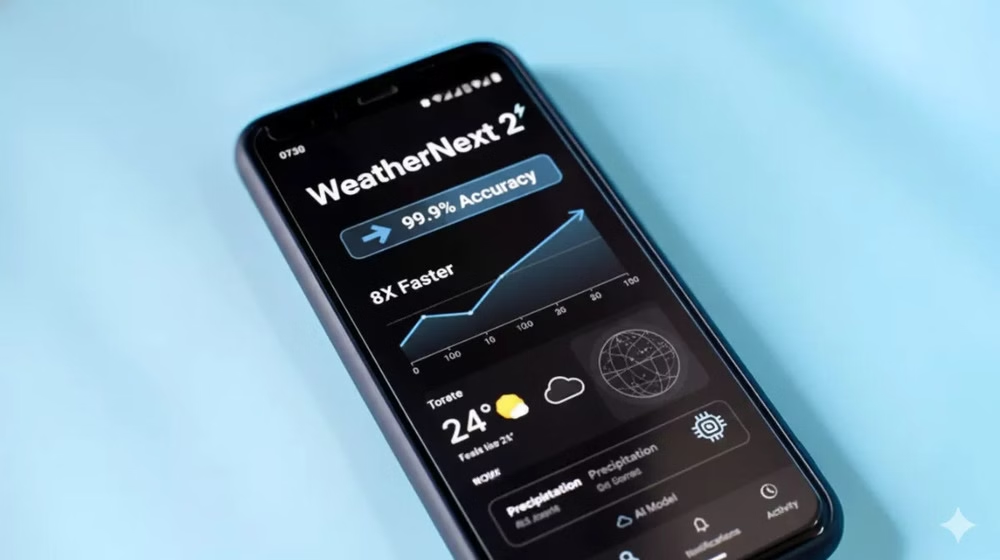Google AI Weather Forecasting has taken a major leap forward as the company announced a significant upgrade to its prediction technology. This advanced system, now integrated into Search, Maps, Gemini, and Pixel devices, uses artificial intelligence to deliver faster, more accurate, and more efficient weather forecasts than traditional models. By transitioning its research-stage technology into real-world use, Google is aiming to improve how millions of people access weather information daily.
A Shift From Experimentation to Real-World Use
For several years, Google has been testing AI-powered weather prediction tools. These systems were designed to outperform conventional physics-based forecasting methods, which depend on complex atmospheric simulations. According to Google DeepMind’s senior director of research and sustainability, Peter Battaglia, the company is now confident enough in its results to move beyond experimentation. He explained that the forecasts have consistently proven effective and useful,making it the right time to bring them directly to consumers.
This shift highlights Google’s broader push to integrate artificial intelligence into practical, everyday applications. With this latest development, Google AI Weather Forecasting becomes a core part of the company’s digital ecosystem.
Faster and More Accurate Predictions
At the center of the upgrade is Google’s new model, WeatherNext 2. This AI-driven system delivers forecasts eight times faster than the previous version and improves accuracy across 99.9% of measured weather variables. Temperature, wind speed, cloud cover, and other conditions are all predicted with higher precision.
One of the biggest advantages of WeatherNext 2 is speed. Using just a single Google TPU chip, the model can generate predictions in under a minute. Traditional forecasting systems, which simulate atmospheric physics, often require massive supercomputers running for hours to calculate results. By learning from decades of historical weather patterns, Google’s AI eliminates much of the heavy computational work. This efficiency makes detailed weather data more accessible and more quickly available to both consumers and industries.
The Technology Behind WeatherNext 2
The accuracy and speed of Google AI Weather Forecasting are largely due to the company’s new Functional Generative Network (FGN). Older AI models had to process the same information repeatedly to produce a full forecast, which slowed down the entire system. FGN changes this by adding controlled randomness to each input, enabling the model to generate hundreds of forecast variations in a single pass.
This approach not only improves processing efficiency but also provides better uncertainty analysis. Instead of offering one fixed prediction, WeatherNext 2 produces a range of possible outcomes, giving users and industries a clearer understanding of weather risks and probabilities.
Extended Range and Hourly Updates
Another key improvement is the model’s ability to generate predictions up to 15 days in advance. Traditional systems often struggle with accuracy beyond a week due to atmospheric complexity, but the AI-based approach helps extend prediction reliability.
WeatherNext 2 also provides hourly updates, making it useful for industries that rely on precise timing. According to Akib Uddin, a product manager at Google Research, sectors such as transportation, energy, agriculture, and logistics all benefit from timely, high-resolution forecasts. For businesses that need minute-to-minute and hour-to-hour climate data, the enhanced capabilities of Google AI Weather Forecasting offer a significant advantage.
Expanded Availability Across Google Products
One of the most exciting aspects of this upgrade is how widely Google plans to roll out its new forecasting technology. WeatherNext 2 will appear across various Google platforms, ensuring users get consistent and high-quality weather information no matter which service they use. This includes:
- Google Search
- Google Maps
- The Gemini AI assistant
- Pixel Weather app
For businesses and researchers, Google is launching an early access program that provides custom weather modeling tools. Forecast data will also be accessible through Google Earth Engine for geospatial projects and BigQuery for large-scale data analysis.
What This Means for Users and Industries
The integration of Google AI Weather Forecasting into everyday services marks an important moment for weather technology. Faster processing, higher accuracy, and expanded availability mean users can rely on more detailed and timely information. Whether planning a daily commute, scheduling agricultural operations, or managing renewable energy systems, industries and individuals alike will benefit from this leap forward.
By turning cutting-edge research into practical tools, Google is setting a new standard for weather forecasting in the digital age. WeatherNext 2 and its underlying AI innovations are poised to make weather predictions smarter, quicker, and more accessible than ever before.


